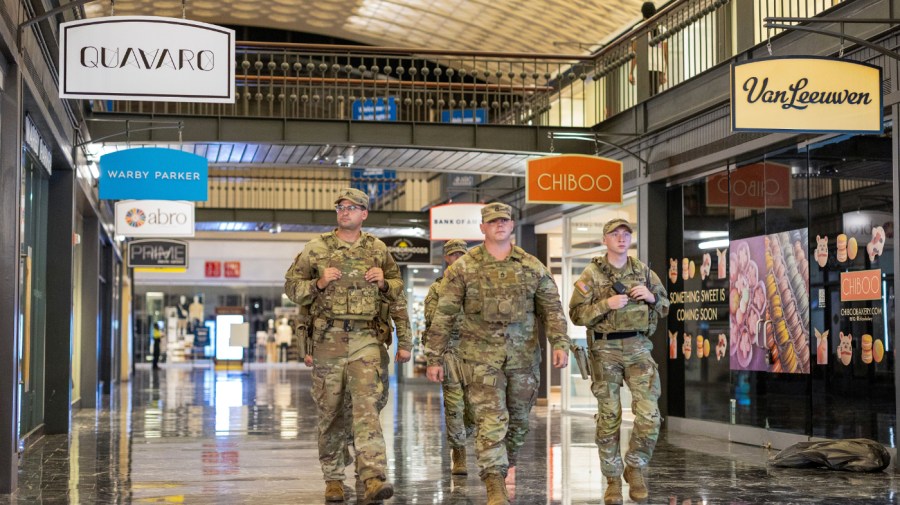
In August, President Trump claimed Saying that crime in the District of Columbia was “out of control” Destruction “Endangers public servants, citizens, and tourists, disrupts safe transportation, and the proper functioning of the federal government.” to save the capital “Bloodshed, mayhem, filth and worse,” The President issued an executive order based on a provision home rule actDeclaring a state of emergency, authorizing a takeover of the city’s Metropolitan Police Department, and bringing National Guard troops into Washington to restore order.
“We now have a very safe city,” Trump said. announced Less than two months later. It is “an objective fact” that crime has declined dramatically, a White House spokesperson insisted: Compared to the same period in 2024, total crime decreased by 17 percent, murders decreased by 50 percent, assaults with a deadly weapon decreased by 16 percent, and robberies decreased by 22 percent.
Five of the eight states sending troops to D.C. — Georgia, South Carolina, Mississippi, West Virginia and Ohio — have set dates. Removal this fall. Others are also expected to leave soon. The order for more than 900 members of the D.C. National Guard has been extended through December.
Was the operation successful?
As crime analyst and co-founder of AH Datalytics Jeff Asher says, “You need months and months of this data to be able to draw conclusions. If crime was falling before you intervened and it continues to fall, what does that show?”
Here’s a review of the information the White House did not cite. Violent crime in Washington reaches 30th year Less In 2024. This downward trend Ongoing In the first half of 2024, violent crime declined by 26 percent and homicides declined by an additional 13 percent year over year.
In the four weeks before the executive order took effect, more violent crimes were committed with a firearm. dropped From 97 to 65. In early August, residents reported seven violent crimes per day to police; The average dropped to 5 or 6 in mid-August, but recovered to seven by the end of September.
Although National Guard troops had the authority to make arrests, Defense Secretary Pete Hegseth told“They will not be involved with law enforcement.” Kingsley Wilson, Pentagon Press Secretary, Confirmed That they “will not arrest people.”
of 550 people were arrested In the first 13 days of the operation, 527 were captured by Metropolitan Police Department officers; Of the detained individuals, 225 were accused of being undocumented immigrants and three were alleged to be gang members.
A quarter of the 550 crimes were not listed as crimes but as “other”. Ward 8 Council Member Trayon White as (D) told reporters“Most of it was no papers, a lot of frivolous allegations.”
The activities of National Guard troops were often unrelated to crime. In addition to providing administrative and logistical support for the MPD, they patrolled parks, the National Mall, subway stations, and many neighborhoods – sometimes armed, sometimes reassuring, and sometimes harassing or angering residents. Soldier taken out Murali, helped run the soup kitchen, “disposed of 1,015 bags of garbage, spread 744 cubic yards of mulch, removed five truckloads of plant waste, cleaned 6.7 miles of road, painted 270 feet of fence.”
It’s no surprise that Mayor Muriel Bowser (D), with whom Trump repeatedly did not consult before issuing his executive order told That deploying the National Guard is not an efficient use of resources.
As Virginia Burger, a senior defense policy analyst at the Project on Government Oversight, emphasized, an operation of this scale “Not cheap.” According to an internal budget document obtained by USA TODAY, the cost of National Guard personnel assigned to the presidential initiative (968 from D.C. and 1,300 from out of state) is approximately $1.8 million per day. Expenses include salaries, transportation, hotel rooms, meals, and laundry services.
A reduction in annual government appropriations for the National Guard, whose tasks, until now, came with the support of local authorities and typically include recovery from natural disasters and helping to suppress riots, Maj. Gen. Greg Porter Gave the signal. Trump’s deployment would make it difficult to keep troops “trained, equipped and ready to respond to our nation’s call.”
A citizen critic has calculation That the daily cost of the “Invasion of DC”, which included destroying 50 homeless encampments, is equivalent to one-quarter of the cost of operating public housing for all homeless persons in the nation’s capital on any given night. Note that public housing reduces crime and improves education and health outcomes.
Again, there are a number of reasons – cost, efficient use of personnel and resources, a hallowed Democratic tradition of keeping the military out of domestic politics – why the National Guard and the US Army are not ordered to assist in crime prevention. Since 1894.
And here’s another reason: Even if Trump is right that Washington, D.C., is now “a safe city,” what’s to stop the nation’s capital from returning to a state of “crime, bloodshed, unrest, filth and worse” once the troops return home?
Glenn C. Altschuler is the Thomas and Dorothy Litwin Emeritus Professor of American Studies at Cornell University.












